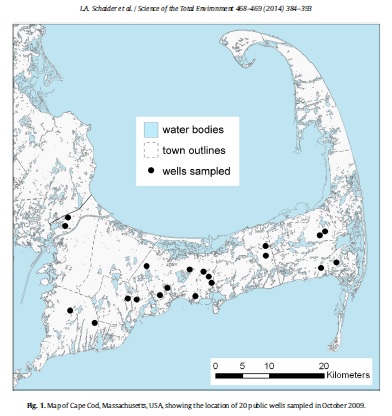Antibiotics, prescription drugs, flame retardants identified in Cape Cod drinking water supplies
A recent study from the Silent Spring Institute (http://www.silentspring.org/) (Newton, MA) has shed further light on the drinking water quality in Cape Cod.
Approximately 40% of U.S. residents rely on groundwater as a source of drinking water. Groundwater, especially unconfined sand and gravel aquifers, is vulnerable to contamination from septic systems and infiltration of wastewater treatment plant effluent. Of particular concern is the new class of emerging contaminants (CECs) that include hormones, alkylphenols, and endocrine disrupting compounds (EDCs). These compounds have been linked to reproductive effects in fish and other freshwater organisms. There are concerns relating to the human health effects from the presence of these contaminants in drinking water supplies with growing evidence of chemical activity at low levels of exposure.
Septic systems are responsible for the wastewater treatment in up to 20% of US homes, with septic systems failing on average every 20 – 30 years. Septic systems can pose an increased risk of groundwater contamination in areas with sand and gravel aquifers – for example in Cape Cod, Massachusetts, USA.
Septic systems appear to be the primary source of OWCs in Cape Cod groundwater. The two most frequently-detected chemicals were sulfamethoxazole (antibiotic) and per!uorooctane sulfonate (per!uorosurfactant). Maximum concentrations of sulfamethoxazole (113 ng/L) and the anticonvulsant phenytoin (66 ng/L) matched or exceeded maximum reported concentrations in other U.S. public drinking water sources.
Results demonstrated that of the 20 public wells sampled through-out Cape Cod, 60% of the drinking water sources contained antibiotics, 35% contained flame retardants, 25% contained prescription drugs.
The current literature is lacking in understanding the potential health implications for the emergence of these contaminants in drinking water supplies. Health based guidelines are not available at all or are inadequate because of a lack of toxicity information and limited toxicity testing requirements. Furthermore, while this particular study included a diverse list of nearly 100 contaminants, there are about 80,000 chemicals currently in use, suggesting that other contaminants, were also present in our samples.
Next generation solutions for septic system waste water treatment will be required so as to mitigate the risks posed by septic system ground water contamination. At Clear Pod Inc. we are developing drop-in retrofit solutions that enhance septic system performance and reduce the concentrations of contaminants leaving the system.
For more information see:
http://www.clearpodwater.com/
http://www.easthamwater.com/wp-content/uploads/2013/02/Silent-Spring-Study-on-Drinking-Water.pdf
